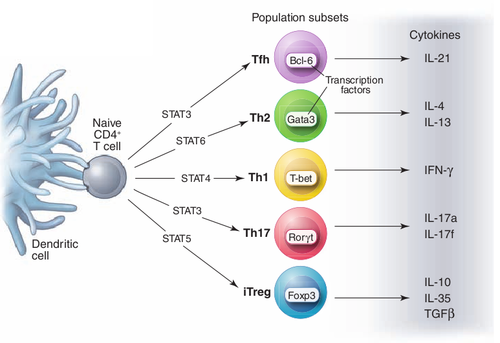T helper cell

T helper (Th) cells play an important role in the adaptive immune system. T helper cells are often distinguished from cytotoxic T cells by the surface antigens CD4 and CD8. T helper cells carry the CD4 surface antigen while cytotoxic T cells carry the CD8 surface antigen. T helper cells and cytotoxic T cells are the best known types of T cells.
Th1[edit | edit source]
Th1 cells are a subset of T helper cells that are involved in cell-mediated immunity against viruses and intracellular bacteria. They are triggered by IL-12, IL-2 and their effector cytokine is IFN-γ. The main effector cells of Th1 immunity are macrophages as well as CD8 T cells, IgG B cells, and IFN-γ CD4 T cells.
Autoimmune diseases characterized by a Th1 immune profile include rheumatoid arthritis, multiple sclerosis, type 1 diabetes, Sjögren's syndrome and Crohn's disease.[citation needed]
Th2[edit | edit source]
Th2 cells are a subset of T helper cells that are involved in humoral immunity against extracellular parasites, bacteria, toxins and allergens. They are triggered by IL-4 and their effector cytokines are IL-4, IL-5, IL-9, IL-10 and IL-13. The main effector cells are eosinophils, basophils, and mast cells as well as B cells, and IL-4/IL-5 CD4 T cells.
Autoimmune diseases characterized by a Th2 immune profile include Lupus, scleroderma, inflammatory bowel disease, and Asthma.[citation needed] Chronic fatigue syndrome may be characterized by a Th2 cytokine profile.[1][2]
Th17[edit | edit source]
The T-helper cell 17 (Th17) lineage is a recently discovered subset of effector memory T cells.
Modulating the Th1/Th2 balance[edit | edit source]
There are many compounds that have been suggested to suppress a Th2-mediated immune response, inducing a shift toward a Th1-type response. These include ginger[3], reishi[4], licorice[5] and astragalus[6]. These have not been tested for efficacy in ME or CFS patients.
Histamine[7] and mold[8] increase a Th2 response.
See also[edit | edit source]
Learn more[edit | edit source]
References[edit | edit source]
- ↑ Skowera, A.; Cleare, A.; Blair, D.; Bevis, L.; Wessely, S.C.; Peakman, M. (February 2004). "High levels of type 2 cytokine-producing cells in chronic fatigue syndrome". Clinical and Experimental Immunology. 135 (2): 294–302. doi:10.1111/j.1365-2249.2004.02354.x. ISSN 0009-9104. PMC 1808936. PMID 14738459.
- ↑ Patarca, Roberto (2001). "Cytokines and Chronic Fatigue Syndrome". Annals of the New York Academy of Sciences. 933 (1): 185–200. doi:10.1111/j.1749-6632.2001.tb05824.x. ISSN 1749-6632.
- ↑ Ahui, Marie Louise Berthe; Champy, Pierre; Ramadan, Abdulraouf; Pham Van, Linh; Araujo, Luiza; Brou André, Konan; Diem, Séverine; Damotte, Diane; Kati-Coulibaly, Séraphin (December 10, 2008). "Ginger prevents Th2-mediated immune responses in a mouse model of airway inflammation". International Immunopharmacology. 8 (12): 1626–1632. doi:10.1016/j.intimp.2008.07.009. ISSN 1567-5769. PMID 18692598.
- ↑ Jan, Rong-Hwa; Lin, Teng-Yi; Hsu, Ya-Chun; Lee, Shiuh-Sheng; Lo, Shih-Yen; Chang, Mingi; Chen, Li-Kuang; Lin, Yu-Li (2011). "Immuno-modulatory activity of Ganoderma lucidum-derived polysacharide on human monocytoid dendritic cells pulsed with Der p 1 allergen". BMC Immunology. 12 (1): 31. doi:10.1186/1471-2172-12-31. ISSN 1471-2172.
- ↑ Bordbar, Narges; Karimi, Mohammad Hossein; Amirghofran, Zahra (November 2012). "The effect of glycyrrhizin on maturation and T cell stimulating activity of dendritic cells". Cellular Immunology. 280 (1): 44–49. doi:10.1016/j.cellimm.2012.11.013. ISSN 1090-2163. PMID 23261828.
- ↑ Wang, Gang; Liu, Chun-tao; Wang, Zeng-li; Yan, Cun-liang; Luo, Feng-ming; Wang, Lei; Li, Ting-qian (December 2006). "Effects of Astragalus membranaceus in promoting T-helper cell type 1 polarization and interferon-gamma production by up-regulating T-bet expression in patients with asthma". Chinese Journal of Integrative Medicine. 12 (4): 262–267. ISSN 1672-0415. PMID 17361521.
- ↑ Packard, Kathleen A.; Khan, Manzoor M. (July 2003). "Effects of histamine on Th1/Th2 cytokine balance". International Immunopharmacology. 3 (7): 909–920. doi:10.1016/S1567-5769(02)00235-7. ISSN 1567-5769. PMID 12810348.
- ↑ Schütze, Nicole; Lehmann, Irina; Bönisch, Ulrike; Simon, Jan C.; Polte, Tobias (June 1, 2010). "Exposure to mycotoxins increases the allergic immune response in a murine asthma model". American Journal of Respiratory and Critical Care Medicine. 181 (11): 1188–1199. doi:10.1164/rccm.200909-1350OC. ISSN 1535-4970. PMID 20194814.

